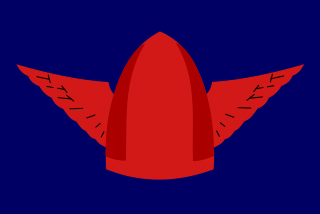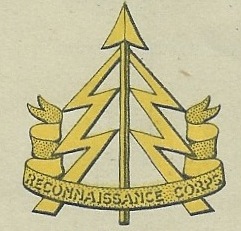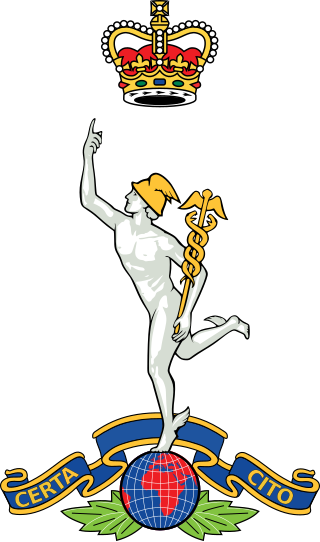
The 43rd (Wessex) Infantry Division was an infantry division of Britain's Territorial Army (TA). The division was first formed in 1908, as the Wessex Division. During the First World War, it was broken-up and never served as a complete formation. It was reformed in the TA in 1920, and then served in the campaign in North West Europe from June 1944 until May 1945, during the Second World War. The division suffered heavy casualties and gained an excellent reputation. After the Second World War, the division formed part of the postwar TA, and became the 43rd (Wessex) Division/District in 1961. It was finally disbanded in 1967.
The 130th Brigade, originally the Plymouth Brigade was an infantry formation of Britain's Volunteer Force, Territorial Force, and later Territorial Army (TA). In the First World War the brigade was in British India for most of the war and did not see service as a complete formation, but many of its battalions fought in the Middle East campaigns. The brigade did see action during the campaign in North West Europe of the Second World War, distinguishing itself at actions such as Operation Jupiter, the capture of Mont Pinçon, Operation Market Garden, at 'Dorset Wood' and at Hengelo. As 130 Brigade it continued in the postwar TA until 1961.

The 214th Infantry Brigade was an infantry brigade of the British Army raised during the Second World War that saw active service on the North West Europe.

The 43rd (Wessex) Reconnaissance Regiment was a regiment of the British Army's Reconnaissance Corps, itself part of the Royal Armoured Corps, during World War II. It fought in North West Europe with the 21st Army Group in 1944–1945. Throughout most of its existence the regiment was part of the 43rd (Wessex) Infantry Division.

55th (Wessex) Field Regiment was a unit of the Royal Artillery in Britain's part-time Territorial Army (TA). Its origin was a brigade organised in 1927 from the former West Somerset Yeomanry and field batteries from Wiltshire. Just before the outbreak of World War II the Wiltshire elements were separated to form a second regiment, after which the 55th (Wessex) was often referred to simply as the West Somerset Yeomanry (WSY). It served in Home Forces for the first part of the war, but in 1942 it was assigned to the Guards Armoured Division and served with that formation throughout the campaign in North West Europe, from Normandy to the German surrender in 1945. It continued as an artillery regiment in the postwar TA until 1967.

The 86th Field Regiment, Royal Artillery, was a unit of Britain's part-time Territorial Army (TA) formed after World War I from existing artillery and Yeomanry Cavalry units recruited in Hertfordshire. Its self-propelled guns were among the first artillery to land in Normandy on D Day and served throughout the North West Europe campaign in World War II, seeing action in Normandy, at the liberation of Antwerp, in Operations Market Garden, Clipper and Veritable, the Rhine crossing and the advance across Germany. The regiment continued in the postwar TA until 1967, and its successor battery continued to 2014.
The 1st Somersetshire Engineers was a volunteer unit of Britain's Royal Engineers (RE) whose history dated back to 1868. As the engineer component of the 43rd (Wessex) Division, the unit served in both World Wars, distinguishing itself at the assault crossing of the River Seine at Vernon in August 1944 and in the doomed attempt to relieve the 1st Airborne Division at Arnhem. A detachment also served as airborne engineers in Sicily, Italy and at Arnhem. Their successors served on in the Territorial Army until 1967.

131st Field Regiment was a Royal Artillery (RA) unit of Britain's part-time Territorial Army (TA) created just before World War II. It was formed from part of 80th Field Regiment, Royal Artillery, itself descended from the 1st Lanarkshire Artillery Volunteers, first raised in Glasgow, Scotland in 1859. After serving in home defence the regiment fought in Normandy and through the campaign in North West Europe, distinguishing itself in the action at Asten. It was disbanded after the end of the war.

The 94th Light Anti-Aircraft Regiment, Royal Artillery, was an air defence unit of the British Army during World War II. Initially raised as an infantry battalion of the King's Own Yorkshire Light Infantry in 1940, it transferred to the Royal Artillery in 1941. It served with Guards Armoured Division in Normandy and through the campaign in North West Europe until VE Day.

43 (Wessex) Signal Regiment was a Territorial Army (TA) unit of the British Army's Royal Corps of Signals from 1920. It had its origins in a Volunteer unit of the Royal Engineers formed in the West Country in 1860 and provided the communications for the 43rd (Wessex) Infantry Division during World War II. Its successor still serves as a squadron in today's Army Reserve.

The 5th Battalion, Devonshire Regiment, was a part-time unit of the British Army recruited in the county of Devon. It was formed in the Territorial Force in 1908 by amalgamating two existing Volunteer Battalions of the Devonshire Regiment. The battalion served in India and fought in Palestine and on the Western Front during World War I. In World War II it provided two anti-tank artillery units, which served in Tunisia, Italy and North West Europe. They were both merged into other Devonshire units in 1950.

The 116th Light Anti-Aircraft Regiment was a Welsh mobile air defence unit of the British Army's Royal Artillery (RA) during World War II. It served with the 53rd (Welsh) Infantry Division in the campaign in North West Europe.

The 89th Light Anti-Aircraft Regiment, Royal Artillery, was an air defence unit of the British Army during World War II. Initially raised as an infantry battalion of the Buffs in 1940, it transferred to the Royal Artillery in 1941. It served with 49th Infantry Division in Normandy and through the campaign in North West Europe until VE Day.

The 108th Light Anti-Aircraft Regiment, Royal Artillery, was an air defence unit of the British Army during World War II. Initially raised as an infantry battalion of the Green Howards in 1940, it transferred to the Royal Artillery in 1942. It served with 52nd (Lowland) Infantry Division, training for mountain warfare and airlanding operations, but finally went into action at sea level in the Battle of the Scheldt in the autumn of 1944. It fought through the battles in the Rhineland and Germany in 1945 until the end of the war, after which it was disbanded.

The 110th Light Anti-Aircraft Regiment, Royal Artillery, was an air defence unit of the British Army during World War II. Initially raised as an infantry battalion of the Dorsetshire Regiment in 1940, it transferred to the Royal Artillery in 1942. It served with 43rd (Wessex) Infantry Division in Normandy and through the campaign in North West Europe until VE Day.

8th Army Group Royal Artillery was a brigade-sized formation organised by Britain's Royal Artillery (RA) during World War II to command medium and heavy guns. It served in the campaign in North West Europe, participating in the battles in the Orne valley and the bocage south of Caumont before the breakout from the Normandy beachhead, operations to close up to the Maas, and the assault crossing of the Rhine.

The 1st Wiltshire Battery, Royal Field Artillery, and its successors were part-time Territorial Force units of the British Army from 1908 to 1950. It carried out garrison duties in India during World War I and saw active service in the Third Afghan War. It served in various units in the interwar years, finally becoming a full regiment in time for World War II. It saw action with 43rd (Wessex) Infantry Division in the campaign in North West Europe, including Operations Epsom, Jupiter and Bluecoat in Normandy, the crossing of the Seine, the battle for Arnhem in the Low Countries, and then Operations Clipper, Blackcock, Veritable and Plunder across Germany. Its short-lived postwar successor unit had little or no Wiltshire connection.

The 9th Medium Regiment was a Royal Artillery unit, formed in the British Army during World War II. First raised in 1940 as infantry of the Buffs, it was converted to the medium artillery role in 1942 and fought in the campaign in North West Europe. It was disbanded after the war.

The 11th Medium Regiment was a Royal Artillery unit, formed in the British Army during World War II. First raised in 1940 as infantry of the Essex Regiment, it was converted to the medium artillery role in 1942 and fought in the campaign in North West Europe. It was disbanded after the war.

The 61st Carnarvon and Denbigh (Yeomanry) Medium Regiment, Royal Artillery, was a Welsh unit of Britain's part-time Territorial Army (TA) formed after World War I from existing Royal Garrison Artillery and Yeomanry Cavalry units. In World War II it fought in the Battle of France and was evacuated from Dunkirk. It returned to North-West Europe in June 1944, participating in the battles in the Orne valley and the bocage south of Caumont before the breakout from the Normandy beachhead, operations to close up to the Maas, and the assault crossing of the Rhine. The regiment continued in the postwar TA, and a successor unit continues in today's Army Reserve.













